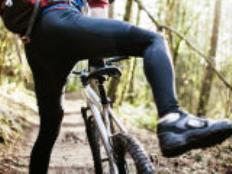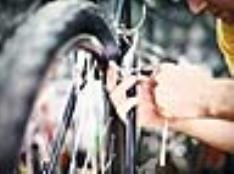Those itching to get off the trainer and onto a real bicycle aren't going to let water and road grit get in their way. And those who live in San Diego, California? Well, there is an outside chance that one day, drops will fall from the sky and soil those perky racing singlets everybody wears.
Sooner or later, everyone will be faced with riding in the rain, and with a little knowledge and the
<a href="https://www.active.com/outdoors/articles/best-rain-jackets" target="_blank">appropriate gear</a>, spinning through showers can actually be an enjoyable experience. How do we know this? We contacted our Pacific Northwest wet-weather expert Philip Booth for a short list of 10 ways to motor through the mist happily—more or less.
Dress to Stay Dry
1 of 11
The wetter you get the colder you are going to be. Being cold and wet is a quick way to get sick. Keep your core warm. A waterproof vest or jacket with a dropped skirt in the back and a hood is critical for heavy conditions. Wear a wicking underliner made from wool or polypropylene and wool socks.
Cover your shoes with neoprene booties to insulate them when they are soaked, and use full fingered water- and wind-resistant gloves. Remember, your body sweats rain or shine, so your jacket and garments must breathe (chose Gore-Tex-type fabrics or ventilated outer garments) or you'll arrive wet from the inside, instead of the outside.
Find:
Your Next RideClear Lenses
2 of 11
In low light, clear or yellow lenses for eye protection are critical. When riding in the rain, normal sunglasses cut out too much light and can make road obstacles hard to see.
If you are still having issues seeing, a cycling cap placed under the helmet will shield some of the rain and road spray from hitting your glasses. Use an anti-fog product (Rain-X is a good value) so you won't become legally blind after waiting for a traffic light.
Find:
Your Next RideRainbow Patches and Puddles
3 of 11
The road surface will be the slickest and most dangerous just after the rain has begun. During this time the rain will cause the oil buildup in the pavement to rise to the surface, causing the road surface to essentially become a giant oil slick.
Keep an eye out for little rainbow-edged patches on the street. This is an indication of an oil patch. Never brake or corner in the center of the roadway at intersections, as this is where autos leave the majority of their drippings. Make an effort to notice metal surfaces such as manhole covers or steel-grid bridge decks, painted traffic markings, or wet leaves, as they all become very slick when wet.
As fun as it may be to bash through puddles, avoid them. More than one cyclist has broken a wheel on a submerged pothole—or submarined into a construction pit that appeared to be a harmless stretch of standing water.
Find:
Your Next RideWatch Those Brake Pads
4 of 11
A mixture of road grit and water turns out to be the fastest method to erode rubber brake pads. Pads that last a full season in the dry will run metal to metal on the rims in a month of wet-weather training rides. Also, most rims require a full revolution before the brake pads squeegee the water from the braking surface and begin stopping. Plan ahead and brake early.
Find:
Your Next RideWatch the Corners
5 of 11
Cornering in the rain can be tricky and dangerous. Shift as much of your weight on the outside pedal as possible. Use body English to keep the bike more upright when cornering. Lean your body more than the bike. By doing this, you will be able to corner with a reasonable amount of speed, as the body will tend to remain balanced over the bike when the tires slide over painted lines and unseen oil patches.
Find:
Your Next RideFenders Unite
6 of 11
Fenders are not foolishness. If you plan on riding for any length of time, or with others, install fenders on both wheels. It will quadruple your comfort factor and keep your vision crystal clear. It's one of the unspoken rules that on rainy-day group rides you should never show up without fenders.
Drafting through a thin stream of grimy water gets old in about 10 meters. Several bike companies sell clip-on fenders that mount to the seatpost and downtube to fit bikes without threaded eyelets.
Find:
Your Next RideMore Fenders
7 of 11
Don't stop there! Once you realize how much better riding with fenders is, you'll want to cut strips from old water bottles to make dangling mud flaps and screw them onto the backsides of your fenders. The longer, the better.
Find:
Your Next RideChain Lube
8 of 11
Use a heavier chain lube. We've had good luck with Phil Wood Tenacious Oil. Go ahead, blob it on that chain—it's better to have a chain that requires cleaning than to have it freeze up with rust. Remember, your lube won't penetrate into the links unless the chain is completely dry when you apply it.
Find:
Your Next RideLight It Up
9 of 11
Let everyone know you are there. Heavy rain and the glare from auto headlights reduce motorists' vision, so it is a good idea to ride with a bright LED lamp on the seatpost and handlebar.
Be seen. LED lights are relatively inexpensive and work reasonably well. A good, rechargeable lighting system will also provide more light than an LED system, something to consider if your rides take place during early morning or evening.
Finally, if you are only going to spring for one light, a flashing red LED rear lamp is an absolute essential for stormy riding. LED lights are inexpensive and most have clips that allow you to attach them to your bike, backpack, or helmet.
Find:
Your Next RideGet a Rain Bike
10 of 11
Really, are you going to trash your race bike? The best investment you can have is a dedicated rain bike. Leave the fenders, the LED lamps, and the mountain bike pedals on your winter bike. When the clouds cut loose, you'll be far happier to submerge your bad-weather beater knowing that your race bike is snuggling next to the fireplace at home.
If you don't already have an old bike hanging in the garage, shop for something with generous room for fenders in the frame and fork.






Discuss This Article